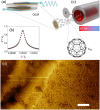Thermally Activated Sliding of C60 on Gold
- PMID: 40584318
- PMCID: PMC12198989
- DOI: 10.1021/acsomega.5c02993
Thermally Activated Sliding of C60 on Gold
Abstract
Gold nanoclusters are known to slide easily on a graphite surface. In this study, we confirm the slipperiness of the gold-carbon interface by studying the sliding behavior of fullerene adsorbates on gold by using a quartz crystal microbalance (QCM). More precisely, we transfer high-quality gold electrodes deposited on an atomically flat mica substrate to the QCM. By means of an effusion cell, we deposit C60 molecules on the QCM gold electrode kept in ultrahigh vacuum. We observe the pinning of the fullerene adsorbates at room temperature. As the temperature increases above 320 K, the fullerene adsorbates begin to slide. This thermally activated sliding is explained in terms of a simple diffusive model.
© 2025 The Authors. Published by American Chemical Society.
Figures






References
-
- Bowden, F. P. ; Tabor, D. . The Friction and Lubrication of Solids; Oxford University Press, 2001.
-
- Persson, B. N. Sliding friction: physical principles and applications; Springer, 2000; Vol. 1.
-
- Manini N., Mistura G., Paolicelli G., Tosatti E., Vanossi A.. Current trends in the physics of nanoscale friction. Adv. Phys.-X. 2017;2:569–590. doi: 10.1080/23746149.2017.1330123. - DOI
-
- Kim J. H., Fu D. Y., Kwon S., Liu K., Wu J. Q., Park J. Y.. Crossing thermal lubricity and electronic effects in friction: vanadium dioxide under the metal-insulator transition. Adv. Mater. Interfaces. 2016;3:1500388. doi: 10.1002/admi.201500388. - DOI
LinkOut - more resources
Full Text Sources
Research Materials
